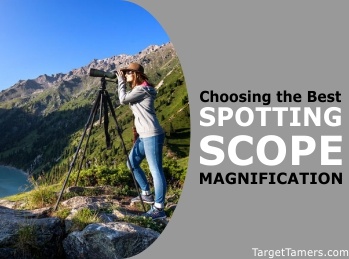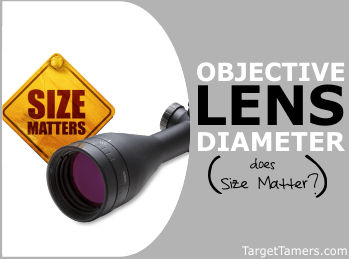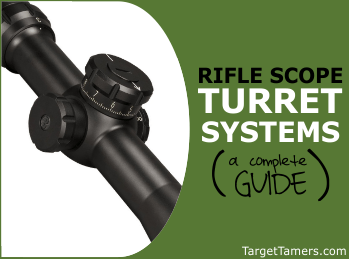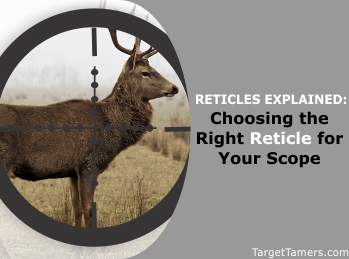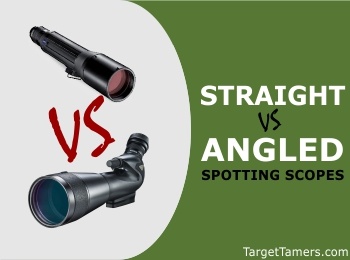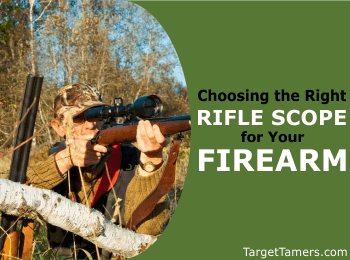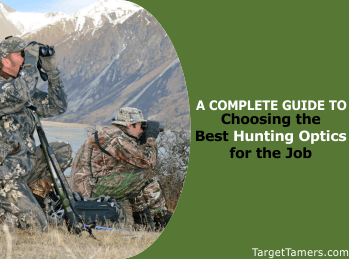
Innovation and production in the optics industry no longer moves at the snail pace of the mid 19th and 20th, centuries.
Hunting optics have not only moved far from the traditional iron sights of the past, they've bound into a new and futuristic age of technological advances that weren't even dreamed about back in the day.
Good thing for every avid hunter, we now live in an era where telescopic sights, binoculars, and even cameras have all had a modern-day makeover, and all to improve the primitive adventure.
From rifle scopes to rangefinders and bow sights to trail cameras, the best hunting optics are reviewed right here in our hunting optics buying guide.
Choosing the Best Hunting Optics for Your Needs
It's never a pleasant feeling finding out at the worst possible moment that your new optics failed to do the job. Neither is realizing you over-spent on a device that has more features than you can ever use. While scopes and sights may be similar in function and purpose, there are differences between the two that should be noted.
While the differences aren't always black and white, there are some types of optics that often float between the two categories and still be applicable to both.
Sights
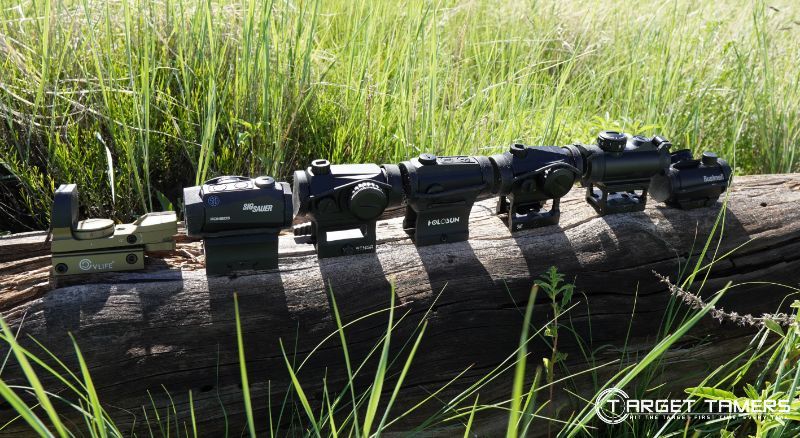
Both scopes and sights can incorporate a sophisticated optical system to compensate for things like windage, parallax, elevation, and low light conditions. Sights use a system that require alignment to enable you to get an accurate point of aim on a target. Sights don't usually have any sort of magnification power, and if they do, it's typically very low, like one power. Some types of sights are open, reflex, holographic, telescopic, bow, red dot, laser, and more.
Scopes
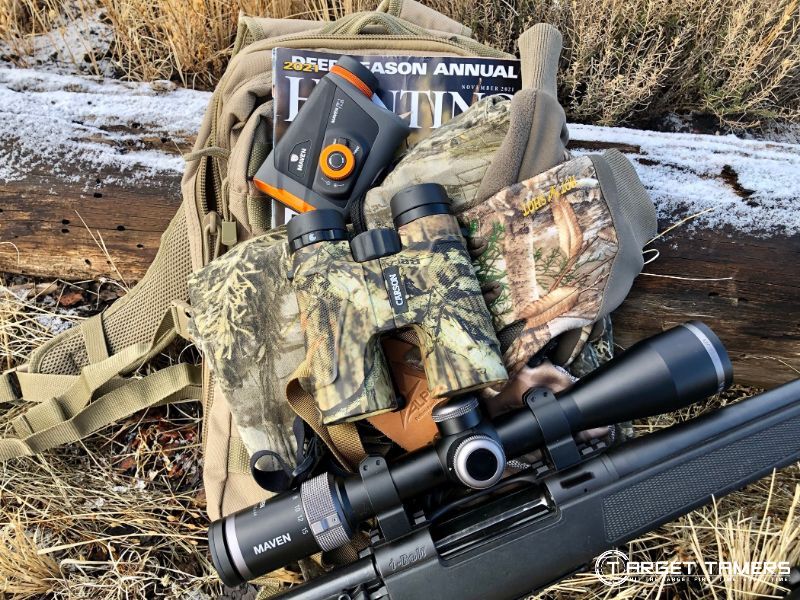
Scopes, on the other hand, are typically made with a tubular-like construction and have varying degrees of magnification power. Various types of telescopic sights also fall into this category. Some examples of scopes are rifle scopes, rangefinders, binoculars, and spotting or field scopes.
How to Choose the Right Optics
A lot of people researching scopes and sights for their next hunting excursion tend to fall on one end of the extreme scale. Either, they want all the bells and whistles for what is going to be a casual affair or they don't get enough flair and accessories for a week long hunt of an elusive animal.
Money and cost aside, if the overkill of features doesn't "kill" your hunt, not enough will. But, navigating what the right tool for the job is can be overwhelming.
Knowing what optics you'll need will be determined by your activities and your needs. As a generic rule of thumb, general shooting and hunting will be best with a low powered optic. Wildlife observers or serious extreme distance hunters may want a more powerful optic without compromising on field of view, whereas field of view wouldn't be a big issue for target shooters.
But, more on the tech specs later. The point is - don't use a sledgehammer to pound in a penny nail and don't use a craft hammer to clobber in a framing nail. Choose the right tool for the job.
⇒ You need to evaluate what you're going to use the optics for...
- Waterfowl hunting where you need a wide field of view and magnification?
- Long distance, big game hunting where you need magnification and scanning abilities?
- Close range hunting in wooded areas where you need a wide field of view and perhaps both eyes open?
- Extreme distance target shooting on stationary targets where you need high powered magnification and a scope that can withstand recoil?
- Wildlife observing where you need variable zooming abilities, a weight heavy enough to keep a tripod still, but light enough to tote in the field?
- Speed shooting competitions where aim and accuracy is just as important as trigger speed?
What About Laser Sights?
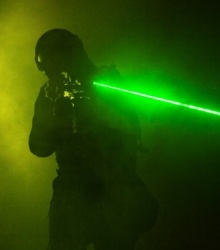
Laser sights might sound like the ideal optical device in a hunting situation since they eliminate the need to either shoulder your firearm or even align it with your line of sight. The red/green laser dot visible on the target is confirmation enough that you have good-enough accuracy and aim.
However, laser sights have many limitations that don't really make them effective tools for hunting situations.
Laser sights are extremely sensitive to atmospheric conditions, and that alone makes it a touchy device to depend on while hunting. The laser has to make it all the way from the firearm, to the target, and still come back while being visible to the operator.
Because of reflectivity factors, weather conditions, and lighting conditions, these types of sights are not dependable. The laser can only be seen if it's on a reflective-enough surface, and for long distances out in the open field, this can be a problem.
Think of a deer in a field against a clear sky for a backdrop. No laser light will be visible unless you're close enough to get it on the prey. Because of all these limitations, laser sights are probably only effective in very close proximity or if your target is in the shadows around dusk.
Iron/Open Sights
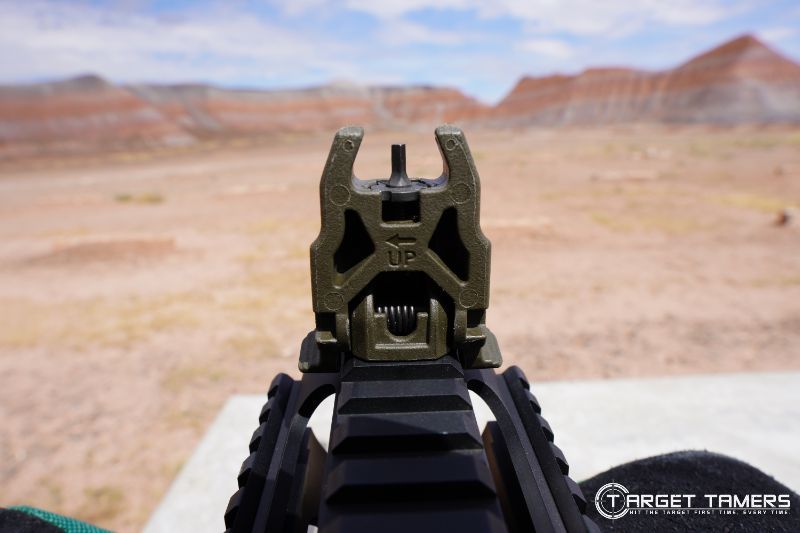
Iron sights are also known as metallic sights since they're often not made out of iron at all. While they're being phased out of the optics industry in favor of detachable scopes and telescopic sights, it's relevant to mention them here for the sake of clarity, since many of our optics articles will mention them as a comparison point.
Open and aperture sights essentially give you the same quality of accuracy with slight variances in the sight components, but they require you to use the same steps for target acquisition. Aligning your eye or line of sight to match the rear and the front sights to create a straight line to the target is an old-school practice that's difficult to master. In fact, simultaneously focusing on three distances, the target, rear sight, and the front sight, is practically an impossible feat.
Despite that, iron sights did their job during the Civil War and paved the way for modern-day optics after World War II. Now, let's take a look at the best hunting optics available to you before you dish out any cash.
Today's Best Hunting Optics
Rifle Scopes
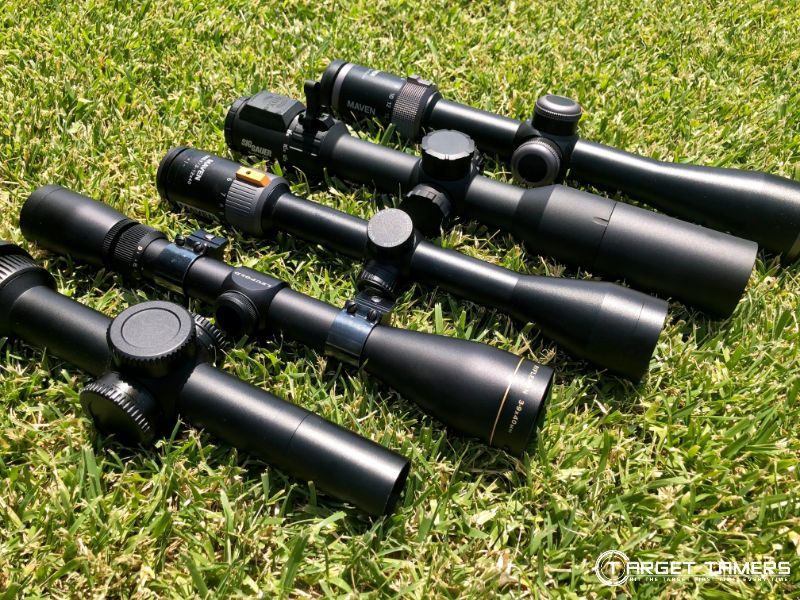
These days, rifle scopes are a common-place accessory for target shooting and hunting. Having moved far from the classic styled, but complex, iron sights of the past, rifle scopes can be mounted to not only rifles (including the ArmaLite AR-15), but handguns and shotguns too. From either variable and fixed vision optics to night vision scopes, you can improve your game with another "set of eyes" to help you make that shot. But, don't go quitting your day job for your favorite outdoor activity just yet.
Of all the various types and quality grades of rifle scopes available, you could spend anywhere between $40 to thousands for fine-tuned features such as parallax, windage, and elevation - and of course there are the additional accessories for the rifle scope to consider. But, despite the price tag, rifle scopes should be simple to use, provide superior accuracy, and enable you to take full advantage of maximum potential your firearm has to offer. If you still miss the shot, maybe you should keep your day job.
Check Out Our Recommended Rifle Scopes
Red Dot/Reflex Sights
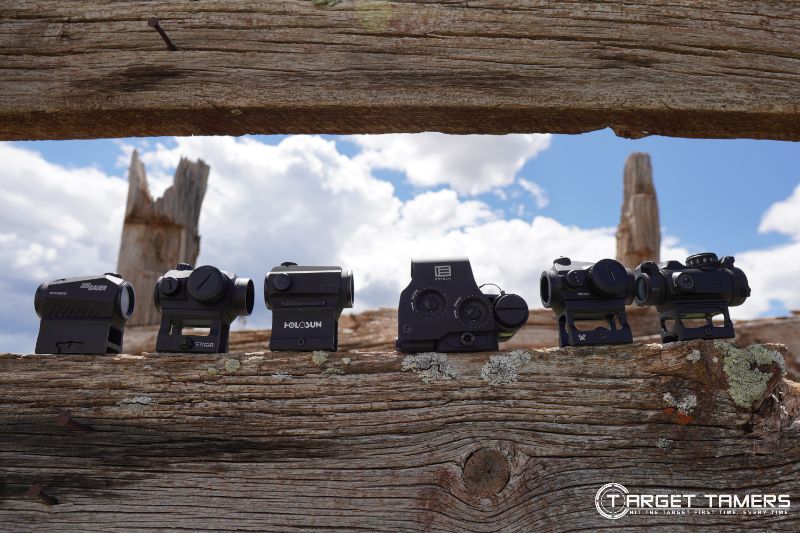
Red dot or reflex sights are your popular tactical sights that can be categorized in either the tubeless, heads-up construction or the scope-styled tube design. While red dot reticles are also a distinct characteristic of holographic sights as well, red dot or reflex sights are different in construction and performance. Using a reflective mirror-imaging optical system, a red dot, sometimes green, appears through the lens parallel to the firearm barrel for close range or fast shooting.
You might want to consider a red dot sight if you're looking for an accessory that's popular among the military, competitive speed shooters, and even waterfowl shotgunners. A red dot may also be a good option if you need a scope for an AR-10. For a more casual affair, an inexpensive red dot sight for a .22 rifle or compact red dot for a handgun would make for a fun plinking afternoon. While hunting or target shooting, red dots can last a long time. If you're worried about the electronic device failing on you when you need it most, you could always double check, while mounting, that it can co-witness with your back-up iron sights just in case.
Check Out Our Recommended Red Dot Sights
Holographic Sights
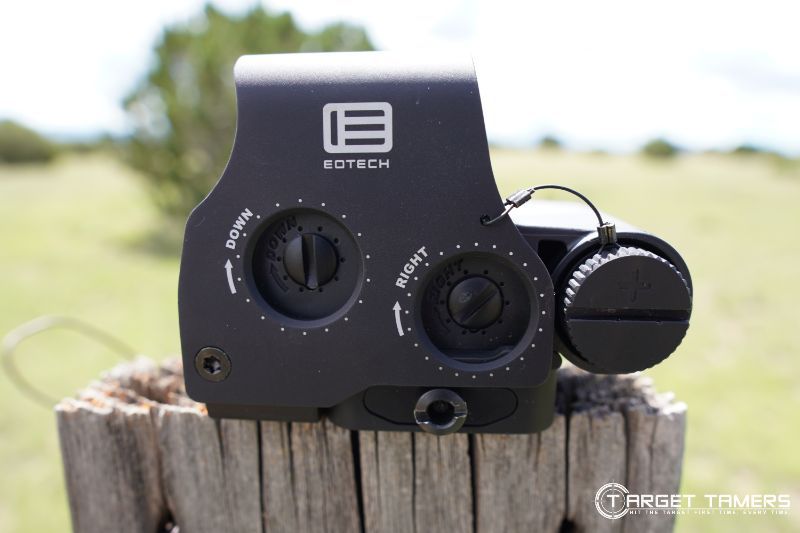
While holographic sights also feature the distinctive red dot aiming reticle, and many more reticle options, they use a different projection system than the reflex sights. By providing a holographic image onto a single, flat glass panel, you can get fast target acquisition and a seemingly "locked on" appearance of the target no matter what angle your eyes are at.
If you're keen on keeping both eyes open while shooting, parallax won't be an issue and accuracy is pretty much guaranteed. It's also possible to get slight magnification with the best holographic sights to enhance your attention on your target and surrounding area ahead.
Check Out Our Recommended Holographic Sights
Bow Sights
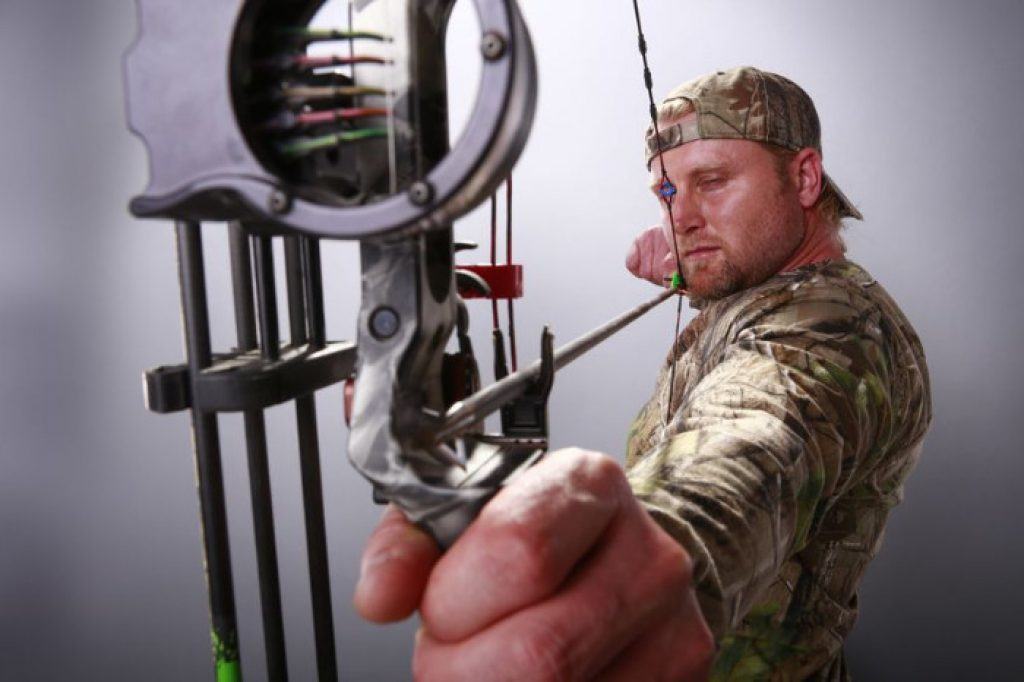
Unless you have excellent instinctive shooting skills, your bow is almost always going to have a sight mounted to it. While bow sights are used to give you bow hunters a pretty precise idea of the trajectory of your arrow, they automatically compensate for elevation changes and windage using adjustable pins. Additional premium features include anti-vibration devices, pin lights, torque adjustments, and more.
While there are some laser rangefinders with angle compensation that can be efficiently used for bow hunting, bow sights are specifically made for the archer in mind. You should also note that there is a large variety of styles of bow sights and its many components and features.
Picking the right one will also depend on various factors including if you're going to be in a tree stand or not, if you'll take part in archery competitions, or if you will be using numerous types of sights often. That's where we come in to help educate you with hunting optics reviews that will enable you to make the most informed decision about which one is right for you.
Check Out Our Recommended Bow Sights
Rangefinders
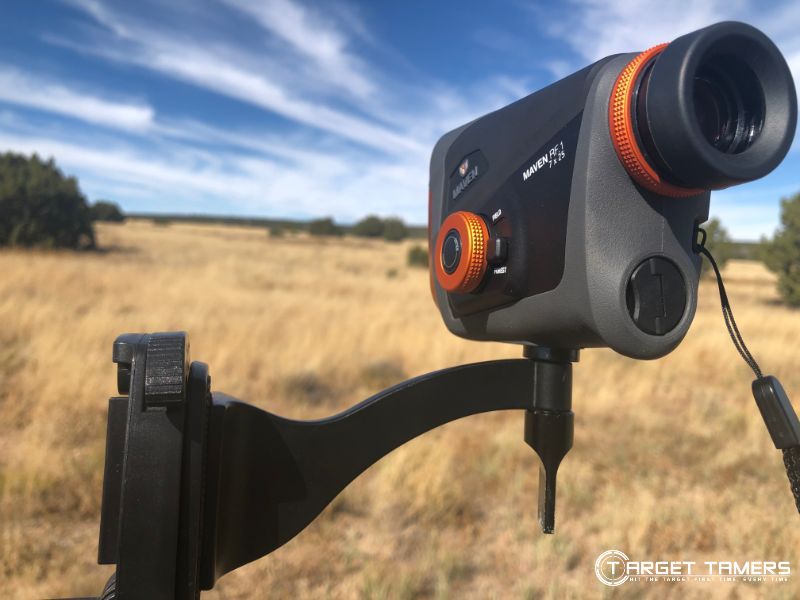
These optical units provide accurate distances so that you can never miss your target again. Laser rangefinders are a necessary tool these days for target shooters, bow hunters, long or short distance shooters, rifle hunters, and even golfers. Half the work while out scouting for your prey is done with a tap and shoot for the right distance.
Rangefinders can also include angle compensation or bullet drop compensation features that allow you to adjust for elevation changes before you take your shot. Furthermore, golf rangefinders can even give you a helping hand with GPS-enabled features.
Hunting rangefinders can help you to zero into the exact location of your prey at extreme distances up to 1300 yards, and some models provide even further yardage with higher magnification. Functional in most types of lighting conditions, weather, and environments, rangefinders can be the difference between a clean shot and a regret.
Check Out Our Recommended Rangefinders
Binoculars
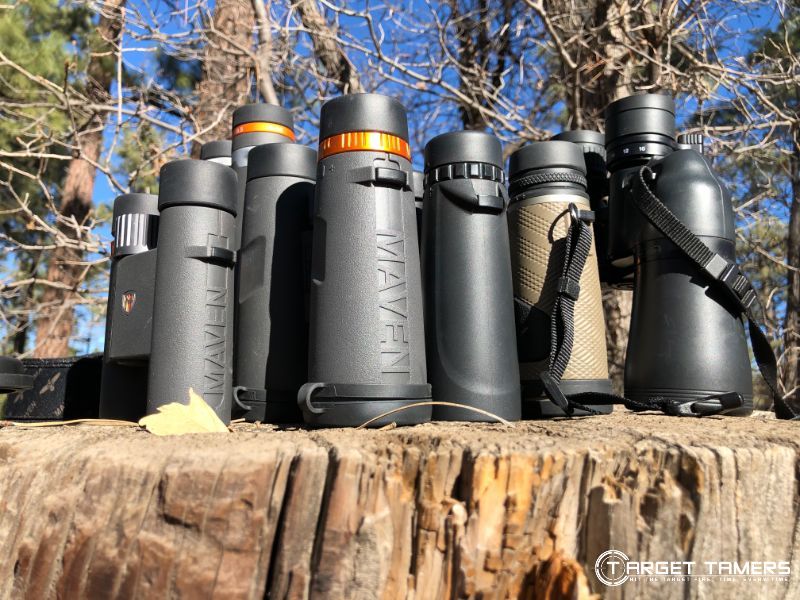
It's self-evident why binoculars are the most popular optic instruments in the world. Whether you're in a tree stand, calling to wild turkeys, or stalking large prey, a convenient, light-weight, and portable, far-seeing pair of eyes is always going to be a beneficial tool.
Hunting with binoculars is a must-have if you want to improve your odds of success, since you can get better magnification of up to 15X, perhaps even more.
While binoculars are just plain fun to use, there's a whole range of varieties of different types available for all aspects of hunting and outdoor recreation.
From wide angle and armored binoculars to center focus and focus-free binoculars, there's bound to be one that will be perfect for your hunting preferences. These binocular reviews will give you all the details you need to know on what magnification to what prism system will work for you so you can get the best hunting optics for sale online.
Check Out Our Recommended Hunting Binoculars
Spotting/Field Scopes
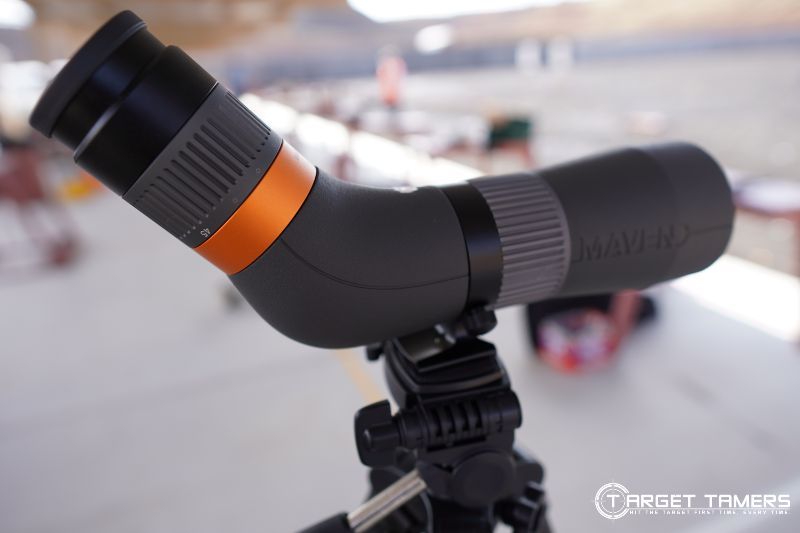
Spotting or field scopes can be compared to both binoculars and telescopes. Call it a monocular binocular or a mini monocular telescope if you will, but I'm getting ahead of myself here. If you're looking for maximum magnification of 25X plus for wildlife spotting from extreme distances, then you might want to consider this type of scope.
Whether it's bird watching or stealthy stalking for a future hunt set-up, spotting scopes are the powerful optics you want.
While they come in both straight and angled models, the angled construction has galloped into rising popularity, along with waterproof and fog-proof features.
Making the decision between binoculars or a spotting scope may be the hardest part of your research. But, once you've decided for the latter, you'll find that it will be much easier than shopping for binoculars since there are far less models to choose from.
Check Out Our Recommended Spotting Scopes
Trail Cameras
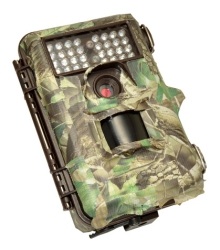
What optics gives hunters their intimate knowledge of their prey's habits, moving patterns, and hot spot locations? Trail, game, or hunting cameras. These nifty, little gadgets are no longer limited to wildlife-filming or use for researchers alone.
After many upgrades and improved technology, trail cameras are now very efficient assets for stealthy hunting adventures of all kinds. From a herd of whitetails to a rafter of turkeys, no game will remain elusive to you.
Whether you're just there to observe and later admire your camera handiwork or to learn, prep, and set up your hot spot for a hunting expedition at high-traffic peak hour, trail hunting cameras can get the job done.
Making the most informed decisions about infrared to white flash cameras, wide detection ranges, super-fast trigger and recovery times, and long-lasting battery lives will be the difference between catching that buck in all his glory or the dust his hooves left behind. The best hunting optics reviews wouldn't be complete without a word or two on the topic.
Factors to Consider When Buying Hunting Optics
There are many different features that are unique to each type of optic. But, there are also similarities in the optical systems that all of them share. When researching the best hunting optics for sale, get familiar with these factors to help narrow down your choice before you buy.
Magnification/Power
Scope model names typically include a series of numbers such as 4X32 or 4-12X32. The 4 and 12 numbers represent the magnification power. You will be able to see your target 4 to 12 times closer. The 4X32 is a fixed power scope - meaning, the scope magnification is fixed at 4X and cannot be magnified more, unlike the 4-12X32 scope that can be "zoomed" up to 12X magnification.
But, don't be fooled. Just because you can get higher magnification, it doesn't mean that bigger is always better. If you're hunting within 250 yards, low powered magnification between the 4X to 6X range is quite appropriate.
Long-distance rifle shooters may want further yard range and 9X to 12X magnification. Wildlife observers or serious extreme distance hunters may want a more powerful optic of upwards of 15X magnification without compromising on field of view where binoculars and spotting scopes may be a better fit.
Remember, sights like red dots and holographic typically do not have any magnification power at all. This could be just fine for close range shooting and hunting, and it also provides for both eyes to be open with a wider field of view.
Objective Lens
The 32 in the 4X32 number series is the objective diameter which tells you how big the outer lens is in millimeters. Larger can be better in this case since it gives you a wider field of view. Field of view is the expanse of area that's visible when looking through the lens of a scope or sight.
The larger the objective lens get, the more you have to pay attention to how well it will mount to your firearm. The mounting scope rings need enough space for the scope to clear the rifle.
Adjustable Objectives
Many high powered scopes come with adjustable objectives to compensate for a condition called parallax. That's when the image, while looking through the scope, is on another focal plane than the reticle. This results in the reticle shifting from the target or aim point whenever you move your eyes or your head to a different angle.
Red dots and holographic sights are what you would consider parallax-free devices, while rifle scopes and other scopes are factory set at about 100 yards to compensate for parallax. When using a scope that has higher than 10X magnification, parallax could be an issue, so it's important that you look for a device that has adjustable objective lens for you to fix for this condition.
Exit Pupil
This value can be calculated from dividing the objective diameter by the magnification power. In this example, 4X32 gives an exit pupil of 8 mm. This is the size of the beam of light that you can see if your eyes were about an inch away from the lens.
This can be applicable to those who wear spectacles, and for those who plan on low light shooting. After sunset, more light can be collected with a larger exit pupil and with the help of your pupils expanding anywhere between 5 to 9 mm.
Reticles
The reticles are the representation of the aiming point that shows up on both sights and scopes. They're also referred to as cross hairs and can take many shapes. Some devices allow you to change the reticle to pre-loaded options.
Some of these shapes can be a dot, dot within a circle, cross, cross within an open circle, and many more. Many people prefer the holographic sights over the red dots for the various reticle options. Because of the way the optical system works in a red dot sight, the only reticle available is the dot.
If the close-range holographic sight has some level of magnifying power, the reticle can stay the same size so as not to interfere with shot placement. However, if you're shooting very long distances, you might want to opt with other types of scopes such as rifle scopes, binoculars, or rangefinders.
Straight and Angled
You'll see these terms pop up here and there, and it can almost be a little confusing to determine its correct placement in hunting optics. In this case, straight and angled refers to the various types of spotting or field scopes you can purchase.
The straight construction has been a long-time favorite and is an easy-to-use device. The angled has risen in popularity because it allows for people of different heights to use it and it can also be used from tree stands. The debate for "either-or" is really a matter of preference.
Angle Compensation
Unlike the makeup of the bow sight that naturally caters for trajectory, angle compensation refers to an internal feature that you'll see in laser rangefinders as well as in some very expensive binoculars.
With this feature, you can use these optics for both shooting and bow hunting activities to compensate for elevation differences, making them very versatile devices. Furthermore, bullet drop compensation is for shooting where the optics device compensates for distances for the gravity pull on the type of bullet in any atmospheric condition.
If you're going to be either bow or rifle hunting in some unpredictable and mountainous terrain, this would be a handy feature to have on your rangefinder or rangefinder binoculars.
Recoil
For a bow sight, you're going to want to get an optic that has an anti-vibration feature. For firearms, you'll want to purchase quality optics for larger caliber firearms or powerful spring air rifles that can withstand recoil.
Some scopes and sights can be mounted with positive stops to minimize rearward motion that causes slippage since clamping pressure alone will not suffice. It's important to properly mount your optics to your firearm to not only prevent damage to your equipment, but also to prevent yourself and others from becoming an accident statistic.
Waterproof/Fog-proof
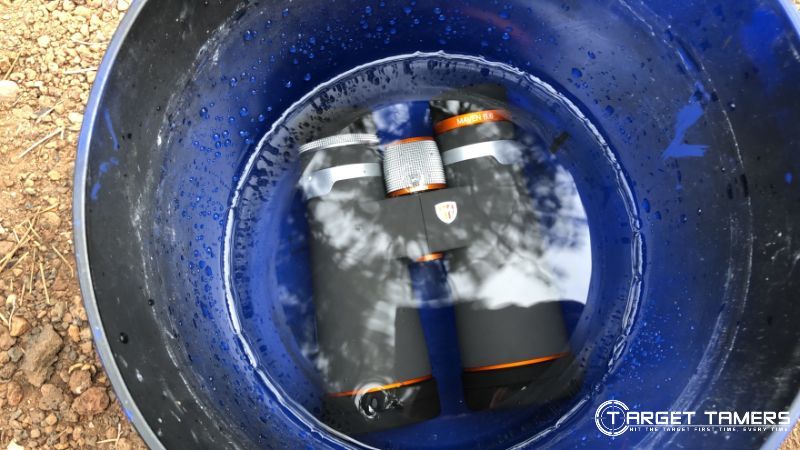
This can be the make-it or break-it feature for many in the market for scopes and sights. While sights are excellent at attaining speedy target acquisition and performing superbly in close ranges, some of their open lens construction can be their downfall in less than perfect weather.
Anytime it rains, snows, or you're in muddy terrain, you'll have to clean the lens every time to keep your vision clear. If you're wanting more durable and weather-proof optics that can survive most types of weather, you'll want to explore the tubular-like scopes that offer more cover protection.
Length and Weight
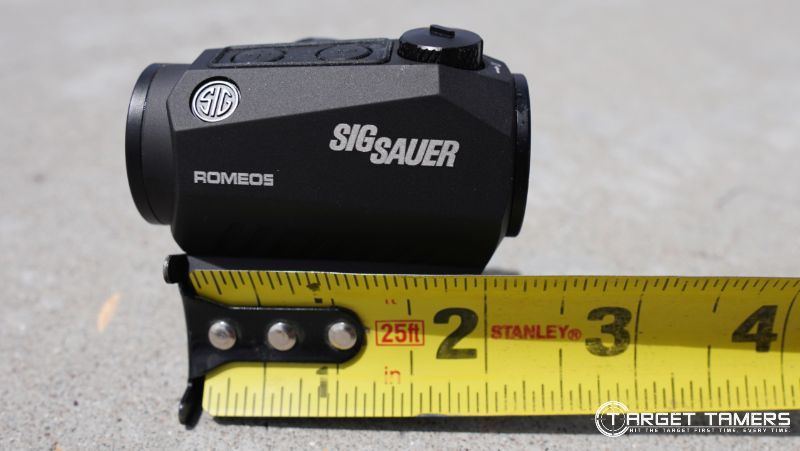
Another factor to consider when you're scrutinizing scopes and sights is the size and weight. Both scopes and sights can be unobtrusive, compact, portable, and very light-weight devices. But, when you're out on a hunt or a wildlife excursion, every added ounce can be an added strain.
While sights are minimal, in terms of weight, scopes have many more lenses and deal with larger diameter sizes that can quickly pack on the ounces. Spotting scopes can be one of the heaviest, portable devices.
Even then, choosing rifle scopes and spotting scopes with fixed power scopes, eyepieces, and medium sized objectives would be lighter than the variable ones. But, on the other hand, heavier optics would sit better on tripods and resist the effects of wind.
Hunting Optics Reviews
These are just some of the factors you'll need to consider if you're in the market for a scope or a sight. There's also more detailed information on scope adjustments, sighting in, bow sight features, optical coatings, and so much more that's covered right here in the best hunting optics reviews.
While just knowing about optics and actually having hands-on knowledge about them are two different things, let me help make that gap a narrow one by giving you all the info you could ever need.
While optics have come a long way, even just over the last decade, hunting and outdoor recreational sports are still age-old, necessary, and beneficial activities. While it's always fun to go back to bare-basic sights for a true, primitive hunt, modern-day optics bring pleasure, competitiveness, precise accuracy, further range, and maybe the chance to earn some bragging rights.
Further Reading
- 10 Good Reasons to Start Using a Hunting Rangefinder Today
- How To Use A Rangefinder To Improve Your Target Shooting Skills
- 5 Tips to Maximize Rangefinder Efficiency in Any Light or Weather
- Glossary of Hunting Rangefinder Terms & Features (Made Easy)
- The Best Angle Compensating Rangefinders & Beginners Guide

